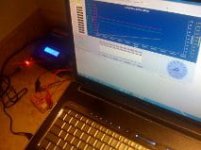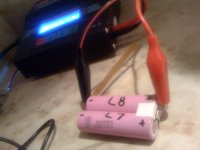I’m going to build my first LiFePo4 pack. I want to start by thanking everyone on this site for sharing their knowledge and experiences, without that I wouldn’t have known where to begin.
I’m going to start by building packs that I can assemble and disassemble for my initial testing to ensure the packs meet my needs before I commit to soldering or spot welding the packs together. I’m going to start out by building four 12v 4sx6p packs. I can then series those together into larger 36v and/or 48v packs. I’m using the thread below as my guide:
Building cylindrical battery pack for Dummy!
http://www.endless-sphere.com/forums/viewtopic.php?f=14&t=17912&start=0
I decided to build them 6p since the continuous discharge rate for these cells is 70A giving me at total of 420A. My largest controller can’t pull over 300A and the one I’ll be doing most of my testing with pulls a max of 150A so I’ll have plenty of cushion and won’t have to worry about accidently destroying them by pulling too many amps.
This is where it gets a little fuzzy, but one 12v 4sx6p pack should give me 60 Ah. My goal was to have at least the capacity of one Optima D34M battery which is rated at 55 Ah (C/20). My setup should be better than the Optima since an SLA can’t deliver its entire capacity when drained quickly (this Optima can’t put out more than 25 amps compared to my 420 amps continuous 720 amps max) so in my application the Ah for the SLA was probably much less than 55 Ah. Also the weight of my pack will be 3.9 lb compared to 43.5 lb for the Optima! Bottom line I hope to get a lot more distance with this setup.
I purchased 108 cells for five bucks each, from this site http://www.buya123batteries.com the cells were listed as a discontinued item.
I was thinking about getting a Turnigy A-6-10 200W Balance charger & discharger to get the cells charged before putting them into the pack.
http://www.hobbyking.com/hobbyking/...y_A_6_10_200W_Balance_charger_discharger.html
I’m going to start by building packs that I can assemble and disassemble for my initial testing to ensure the packs meet my needs before I commit to soldering or spot welding the packs together. I’m going to start out by building four 12v 4sx6p packs. I can then series those together into larger 36v and/or 48v packs. I’m using the thread below as my guide:
Building cylindrical battery pack for Dummy!
http://www.endless-sphere.com/forums/viewtopic.php?f=14&t=17912&start=0
I decided to build them 6p since the continuous discharge rate for these cells is 70A giving me at total of 420A. My largest controller can’t pull over 300A and the one I’ll be doing most of my testing with pulls a max of 150A so I’ll have plenty of cushion and won’t have to worry about accidently destroying them by pulling too many amps.
This is where it gets a little fuzzy, but one 12v 4sx6p pack should give me 60 Ah. My goal was to have at least the capacity of one Optima D34M battery which is rated at 55 Ah (C/20). My setup should be better than the Optima since an SLA can’t deliver its entire capacity when drained quickly (this Optima can’t put out more than 25 amps compared to my 420 amps continuous 720 amps max) so in my application the Ah for the SLA was probably much less than 55 Ah. Also the weight of my pack will be 3.9 lb compared to 43.5 lb for the Optima! Bottom line I hope to get a lot more distance with this setup.
I purchased 108 cells for five bucks each, from this site http://www.buya123batteries.com the cells were listed as a discontinued item.
I was thinking about getting a Turnigy A-6-10 200W Balance charger & discharger to get the cells charged before putting them into the pack.
http://www.hobbyking.com/hobbyking/...y_A_6_10_200W_Balance_charger_discharger.html





